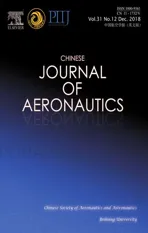A model-scale test on noise from single-stream nozzle exhaust geometries in static conditions
2018-12-26IncheolLEEYingzheZHANGDakaiLIN
Incheol LEE,Yingzhe ZHANG,Dakai LIN
Beijing Aeronautical Science and Technology Research Institute of Commercial Aircraft Corporation of China,Ltd.,Beijing Key Laboratory of Simulation Technology for Civil Aircraft Design,Beijing 102211,China
KEYWORDS Chevron;Engine noise;Engine plug;Jet noise;Single-stream jet
AbstractA model-scale test with single-stream nozzle exhaust geometries was carried out at the anechoic chamber of Beihang University in Beijing,China.The spectral characteristics are investigated,and the effects of the following parametric variations are reported in this paper:impact of nozzle operating conditions on spectra;impact of the presence of a plug;and effectiveness of chevron configurations for noise mitigation.The measurement shows that the change of pressure values has more impact on spectra than the change of temperature values.The spectral change due to pressure is shown at all band numbers for unheated conditions whereas it is more pronounced at highfrequency ranges for heated conditions.An impact of the presence of a plug is also clearly observed.The reduction of noise is moderate up to band number of 35,and becomes more significant at higher band numbers.It is observed that chevron nozzles are more efficient at high pressure and temperature values.It is expected that the quantified analysis will be used to develop an empirical model of single jet noise,which will be the baseline for the development of prediction of noise from turbofan engines of high bypass ratios.
1.Introduction
Jet noise from dual-stream nozzle exhaust geometries,which are typically adopted in modern high bypass ratio turbofan engines,can be assumed to consist ofseveralsubcomponents such as primary jet component and secondary jet component.1,2And each sub-component is treated as an independent noise source of a single-stream nozzle with its own velocity and length scale.Therefore,it is essential to understand the noise characteristics of single-stream jet fiow for the development of prediction of jet noise from dualstream nozzle exhaust geometries.
The prediction of the generation of noise using the equations of motion even from a simple round jet has been elusive due to the complex mechanisms of noise generation.3The acoustic analogy of Lighthill4has been used widely in the analysis and prediction of jet noise.For the past 60 years,many researchers have investigated the characteristics of jet noise experimentally as well as theoretically.5–13However,the prediction methods based on acoustic theory have not met the expectation for practical applications that require not only the prediction of overall sound pressure level but also the spectral predictions at various frequencies and angles with high accuracy.Therefore,many empirical methods based on a comprehensive database of jet noise have been developed.One of the examples of the empirical method is the prediction method compiled by the Society of Automotive Engineers(SAE).14SAE’s method can predict the noise from not only singlestream exhausts but also dual stream exhausts.For single stream jets,master spectra empirically established for different temperature ratios at various emission angles are extrapolated and scaled to a condition to be predicted at.For dual stream jets,the spectral formulae of sub-components are provided,and the total spectrum can be achieved by adding all the sub-components.However,the accuracy of the predictions is not enough for industrial applications primarily for the prediction of jet noise generated by modern turbofan engines with high bypass ratios.Therefore,it is essential to perform a thorough investigation of the characteristics of jet noise from single-stream exhausts to develop an empirical model of jet noise for high bypass ratios with reasonable accuracy.
An experimental investigation on the characteristics of jet noise from single-stream and dual-stream exhaust geometries was carried out at the anechoic chamber of Beihang University(BUAA)in Beijing,China.During the test,a variety of singlestream and dual-stream nozzle exhaust geometries was tested to obtain a comprehensive database for the isolated as well as installed engine jet noise.However,in this paper,only the results of single-stream exhaust geometries are presented.The spectral characteristics are investigated,and the effects of the following parametric variations on noise are reported:(A)at a given nozzle geometry,systematically varying nozzle operating conditions such as pressure ratio and temperature ratio relative to ambient values;(B)impact of the presence of a plug;and(C)effectiveness of chevron configurations for potential noise mitigation.It is expected that the results of the quantified analysis will be used to understand the characteristics of jet noise from the single jet and to develop a robust empirical model of single jet noise,which will be the critical component for the development of prediction of noise from dual-stream nozzle exhaust geometries of high bypass ratios.
2.Experimental set up
2.1.Test facility and measurement system
The experimental test of jet noise from various single stream exhaust geometries was carried out in the anechoic chamber of Beihang University where many acoustic experiments were successfully performed in the past.Fig.1 shows the interior of the chamber with a single-stream nozzle installed on the jet propulsion system.The chamber has a condition of a free sound field with its dimension of 8.9 m?6.8 m?4.65 m and the cut-off frequency is 200 Hz which corresponds to the band number of 23.

Fig.1Single nozzle attached to jet propulsion system at anechoic chamber of BUAA.

Fig.2Photo of jet propulsion system at BUAA.
BUAA has established a jet propulsion system that can supply both unheated and heated jet fiow and support configurations of both single-stream and dual-stream nozzles with various nozzle pressure and temperature ratios relative to ambient conditions.Fig.2 shows a photo of the jet propulsion system at BUAA.Two air compressors and three gas cylinders provide the airflow of the jet propulsion system.The mass fiow rates of the two air compressors are 28.7 and 21 m3/min and the pressure level of the compressors is 0.8 MPa.The volume of the three gas cylinders that are used to store the highpressure gas produced by the two compressors is 51.3 m3.A separate device is installed at the outlet of the air compressor to keep the high-pressure gas dry.The controls of temperature and pressure are all located outside of the chamber for safety and accessibility.
A system for noise measurement,which includes an arc array,of which radius is 3 m,with 11 microphones as shown in Fig.3,data acquisition equipment,a pressure sensor,and a temperature sensor,was set up for the test of jet noise.The microphones used in the jet experiment were the quarter-inch 4939 model of Bru¨el&Kjær(B&K)The preamplifier is B&K’s 2670 model.The default sensitivity of the microphones is 4 mV/Pa and was adjusted for each microphone according to the result of microphone calibration performed every day before the test began.The frequency range of the microphones is 4 to 100000 Hz and the dynamic response range is 35 to 164 dB.The microphone array covers the geometrical angles from 60?to 160?with an increase of 10?,and the reference is set to the exit plane of nozzles.

Fig.3Layout of microphone array.
2.2.Model-scale nozzles
Through the experiment,single nozzles of five different configurations were manufactured and tested as listed in Table 1.Fig.4 shows photos of the two nozzles without a plug.One is a conventional round nozzle(SRNNP1),and the other is a chevron nozzle with 12 teeth of a triangular shape around the circumferential direction(SCNNP1).The length of the nozzle,from the root to the exit plane,is around 300 mmand the diameter D of SRNNP1 at the nozzle exit plane is 30.5 mm,and that of SCNNP1 is slightly less than 30.5 mm.The exit plane of the chevron nozzle is not uniform along the circumferential direction due to the presence of the teeth.So,the chevron nozzle was designed to have the diameter of 30.5 mm at the plane defined by the line that passes the center of the 12 teeth along the circumferential direction.Therefore,the diameter of the chevron nozzle at the exit plane defined by apexes of 12 teeth is slightly smaller than 30.5 mm because the nozzle has a converged shape as shown in Fig.4.

Table 1List of nozzles.

Fig.4Nozzles without a plug.
Fig.5 shows photos of the three nozzles with a plug:a conventional round nozzle(SRNWP1),a sharp chevron nozzle(SCNWP1),and a blunt chevron nozzle(SCNWP2).Both chevron nozzles have 12 teeth around the circumferential direction.The length of the nozzle,from the root to the end of the plug,is 350 mm and the diameter of SRNWP1 at the exit plane is 55 mm,and a plug is located to adjust the exit area and make it equivalent to the exit area of SRNNP1.Therefore,the effective exit area of the two round nozzles is 730.6 mm2regardless of the presence of the plug.Two chevron nozzles(SCNWP1 and SCNWP2)were designed in the same way as SCNNP1 was designed.Therefore,the geometrical diameter of two chevron nozzles at the exit plane is slightly smaller than that of SRNWP1,55 mm,but the effective diameter at the exit plane is set to the same as that of SRNWP1.In other words,the effective diameter Deof all five nozzles is 30.5 mm.Two chevron nozzles are almost identical except the shape of the teeth:sharp triangular teeth and sine curved teeth.To save manufacturing cost and make test procedure efficient,only the tip parts of the nozzle was replaced for different nozzle configurations and all other parts,the main body of the nozzle and the plug were shared across the configurations.
2.3.Test conditions

Fig.5Nozzles with a plug.

Table 2List of nozzle operating conditions.
Table 2 shows the test matrix,in which the total temperature ratio was held constant at values of 1.0,2.1,2.4,and 2.7.Unless otherwise stated,the terminology ‘‘Nozzle Temperature Ratio(NTR)”denotes the total temperature ratio.At each NTR,the Nozzle Pressure Ratio(NPR)was varied systematically from 1.2 to 1.7 to cover a wide range of nozzle operating conditions.The table also shows estimated velocity values at the nozzle exit for each nozzle operating condition calculated by a formula derived based on fundamentals of gas dynamics.It should be noted that the velocities of the majority conditions are higher than the ambient speed of sound,which is about 340 m/s.However,it does not mean these conditions are supersonic because the local speed of sound also increases if the local temperature increases.For example,if a gas condition is set to NTR=2.7 and NPR=1.7,the velocity at the nozzle exit V is estimated to be 479.5 m/s,which is much higher than the ambient speed of sound.But the local speed of sound is estimated to be 523.2 m/s at the defined gas condition,so the local Mach number is expected to be 0.916,which is not supersonic.
3.Results and discussion
3.1.Typical spectral information and repeatability
Fig.6 shows typical spectral contours of noise from a singlestream jet in two frequency scales on the x axis:one in a narrow band or in a linear scale and the other in one third octave band or in logarithmic scale defined as Eq.(1).For example,the frequency value 200 Hz can be converted to 23 in the scale of one-third octave band number Bn.

where f is frequency.
Spectral information in a narrow band is generally used for the analysis of tonal component at high frequency whereas spectral information in one-third octave band is more useful for the analysis of broadband component at low frequencies due to its logarithmic scale.Therefore,it is reasonable to show the analysis results of jet noise in band numbers because jet noise,as well known,consists of a variety of broadband components.For example,as shown on the right-hand side of Fig.6,the most dominant area,shown as white in both contours,is well spotlighted and a component of high frequencies are compressed in a few band numbers with the scale of onethird octave band.
Now it is time to pay attention to angles,the y axis of the spectral contours in Fig.6.In this paper,unless otherwise stated,the terminology ‘‘angle” represents an emission angle,not a geometrical angle.The reference of geometrical angles is set to the plane of the nozzle exit.But in this article,the source of jet noise is assumed to be located at 5Dedownstream from the nozzle exit to define the emission angles.Therefore,the spectra are interpolated from the raw data applying the assumption on the source location.Typically,jet noise shows its dominance at aft angles,from 110?to 160?based on the definition shown in Fig.3,which is also observed in Fig.6.In both contours of thefigure,the peak value shown as white is observed at the angle between 140?and 150?and the amplitude of low to mid angles is relatively low shown as dark grey and black.In this paper,four angles,90?,110?,130?,and 150?are selected with a template shown in Fig.7 to concentrate on the dominant part of jet noise from single-stream nozzle exhaust geometries in the aft angles.The four-angle chart shows the SPL(Sound Pressure Level)values calculated with the reference pressure of 20 lPa at four angles,and the difference of two scales on the y axis is 10 dB.
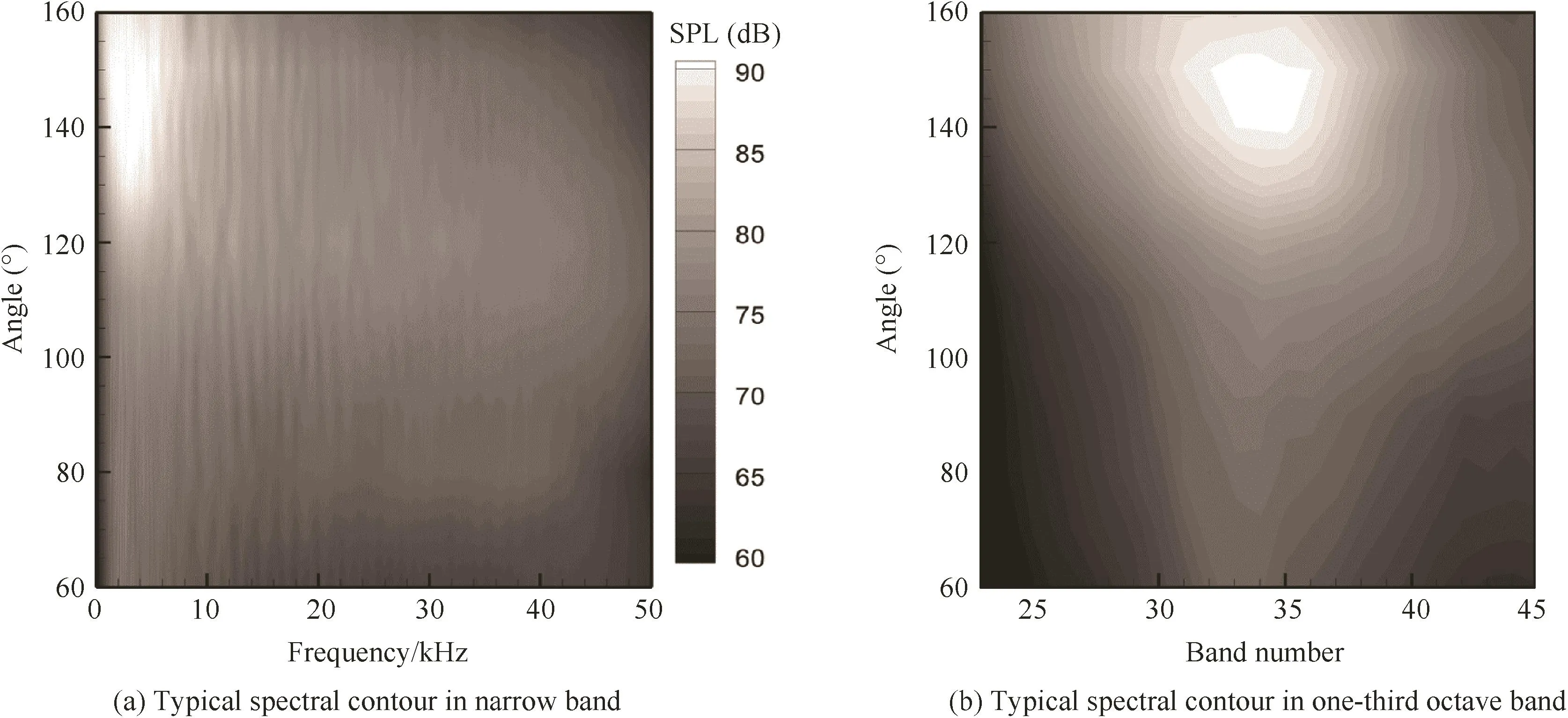
Fig.6Typical spectral contours in narrow band and in one-third octave band.
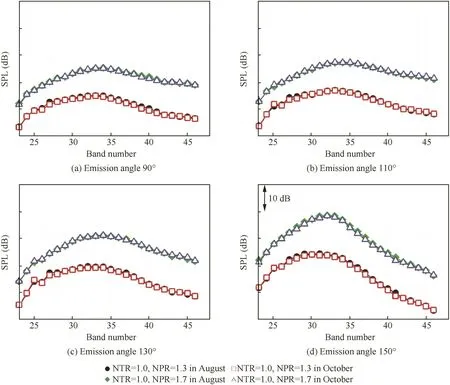
Fig.7Spectral comparison of repeated runs at two different gas conditions.
Since the experiment continued for several months due to the limited and occasional availability of the anechoic chamber,it was essential to secure the quality of measurement and repeatability was one of the leading concerns.Fig.7 shows the spectral comparison of repeated runs at two different unheated jet conditions:low and high NPRs while keeping the temperature unheated,NTR=1.0.For each gas condition,two measurements are compared with each other.The circle and diamond symbols are the spectra measured in August,and the square and delta symbols are the spectra measured in October.The comparisons clearly show that the spectra are on top of each other with a deviation of less than 0.3 dB for each nozzle operating condition.This implies that the measurement system and the facility as well as the jet propulsion system provided excellent repeatability during the test.
3.2.Noise characteristics for various gas conditions
To understand detailed characteristics of jet noise from singlestream exhausts,for a given nozzle,the spectral characteristics of the parametric variations can be examined in two ways:(A)fi x NTR and vary NPR and(B)fix NPR and vary NTR based on the nozzle operating conditions defined in Table 2.
Fig.8 shows the impact of NPR for SRNNP1 at fixed NTR values.In each figure,the circle symbol represents the spectrum ofNPR=1.2,the square symbolrepresentsthatof NPR=1.3,the diamond symbol represents that of NPR=1.5,and the delta symbol represents that of NPR=1.7 respectively.The spectra of unheated jet conditions,shown in Fig.8(a),are contaminated by background noise at low bands such as band number of 25 or 27.The peak component is observed at band numbers between 32 and 35 for both unheated and heated jet conditions.As NPR increases,the spectra also increase with the following trends:(A)the increase of spectra is more pronounced at low NPR;(B)for unheated jet conditions,the increase of spectra is shown as a shape of a shift for all band numbers,however the rate of the shift is not precisely proportional to NPR;and(C)for heated jet conditions,the increase of spectra is more pronounced at high band numbers especially beyond the peak band number.
Fig.9 shows the impact of NTR for two nozzle configurations at fixed NPR values:Fig.9(a)–(c)for SRNNP1 and Fig.9(d)for SRNWP1.In each figure,the circle symbol represents the spectrum of NTR=1.0,the square symbol represents that of NTR=2.1,the diamond symbol represents that of NTR=2.4,and the delta symbol represents that of NTR=2.7 respectively.From Fig.9,it is clearly observed that the spectrum increases as NTR increases,however,the effect of NTR is not as significant as the effect of NPR.The increase of spectra is not consistent along the band numbers but more pronounced at mid-to-high band numbers with an amplitude of less than 4 dB for heated jet conditions,NTR=2.1,2.4,and 2.7.It is also observed that the increase of spectra due to the increase of temperature is more pronounced at peak frequencies at aft angles.For example,the spectral difference between the circle symbol and the square symbol at 130?in Fig.9(c)is different for different band numbers:13 dB at band number 34 and 8 dB at band number 45.It can be concluded that the spectral shape of unheated jet conditions is different from the spectral shape of heated jet conditions.Therefore,the impact of temperature on spectra cannot be described as a simple form across band numbers,and it should be a function of band number.In addition,comparing Fig.9(c)and(d),it can also be concluded that the relative spectral change with respect to NTR is similar between the configurations of with and without a plug,though the shapes of the absolute spectrum are different between the two configurations due to the presence of a plug,which will be investigated in the following section.
The observations on spectra with systematically changing nozzle operating conditions show that the spectral change due to change in NPR is more significant than that due to change in NTR.This is because the velocity at the nozzle exit,which is the critical parameter for thrust,is more sensitive to the change in NPR than NTR as shown in Table 2.For instance,The velocity increases by 40%when NPR changes from 1.3 to 1.7 regardless of NTR values,whereas the velocity increases by 14%when NTR changes from 2.1 to 2.7 regardless of NPR values.In other words,the thrust would increase by 96%when NPR changes by 31%,and it would increase by only 30%when NTR changes by 29%;the increase rate is more than triple.The significant difference of change in velocity and thrust will lead the significant difference of impact on noise as well.It can be concluded that pressure plays a critical role to set up the overall level of jet noise.However,the impact of temperature on jet noise is not clearly identified since the relatively small increase at mid-to-high bands observed in Fig.9 may be the results of two aspects:increased velocity(or massflow rate)and pure temperature effect.Therefore,further investigation is required to understand the impact of temperature on jet noise without including the effect of velocity increase.
3.3.Impact of presence of a plug
A plug is a conical part of the core nozzle,which is widely adopted in modern turbofan engines of high By Pass Ratio(BPR)such as GENX-2B and T1000.The impact of the presence of a plug was investigated with two nozzle configurations,SRNNP1 and SRNWP1.The effective area at the nozzle exit is the same for both nozzles as described in Section 2.2.

Fig.8Impact of pressure ratio for SRNNP1.
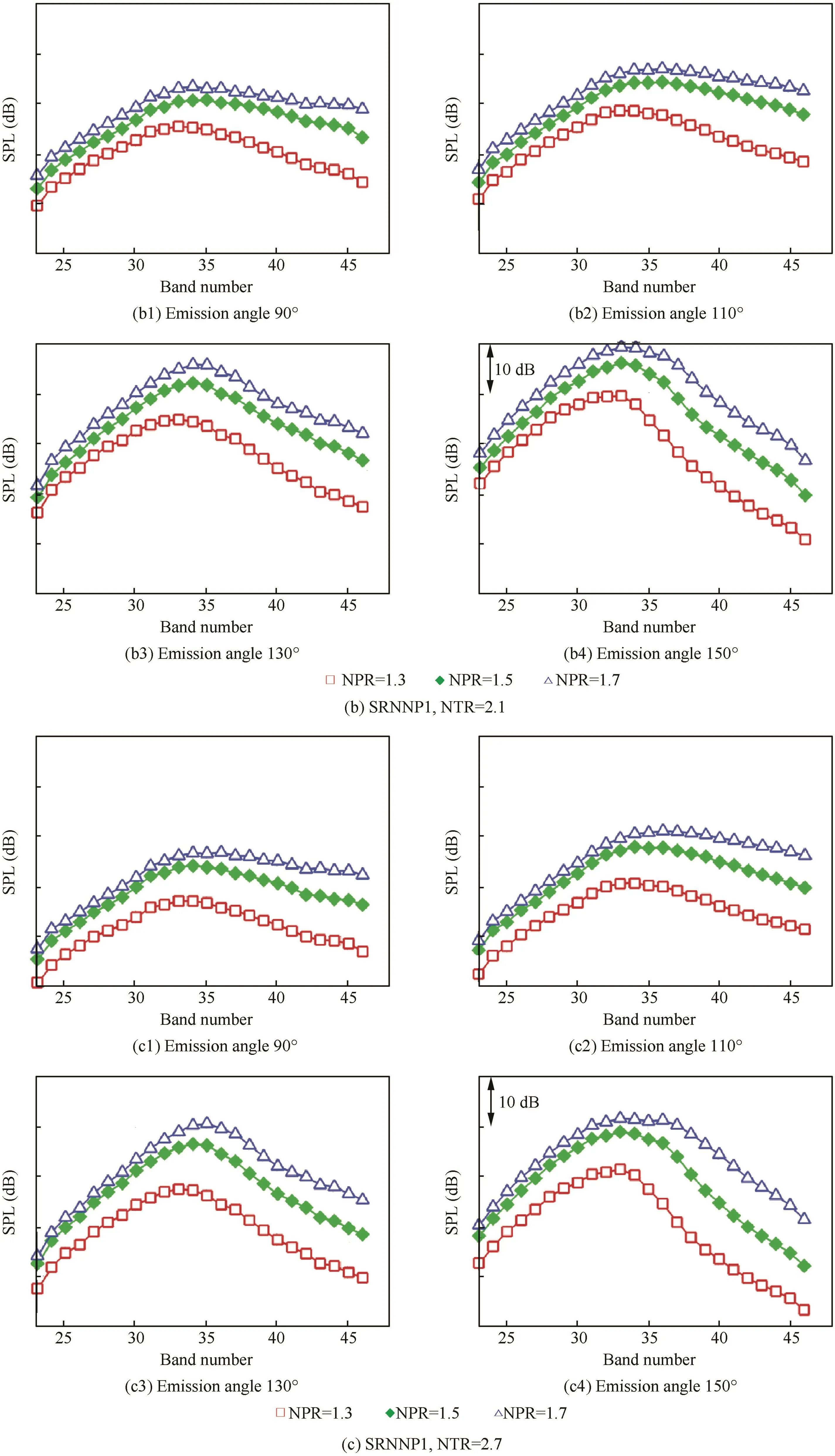
Fig.8(continued)

Fig.9Impact of temperature ratio for NTR for two nozzle configurations.

Fig.9(continued)

Fig.10Spectral contours of two nozzle configurations(NTR=1.0,NPR=1.7).
Fig.10 shows typical spectral contours of the two nozzles and the corresponding delta contour.The absolute spectral contours(see Fig.10(a)and(b))do not provide any distinct difference however the delta contour SRNWP1–SRNNP1(see Fig.10(c))clearly shows the impact of the plug.If there exists a plug,the reduction of noise is small or moderate up to band number of 35,and the reduction gets bigger at high bands,which is not the dominant range of jet noise.Even at high bands,though the reduction due to the presence of a plug is more pronounced at forward and mid angles,the impact of the plug was investigated mainly at after angles,to focus on the dominant region of jet noise,at various nozzle operating conditions as shown in Fig.11 in the form of delta line plots.In each figure,the square symbol represents the delta spectrum of NPR=1.3,the diamond symbol represents that of NPR=1.5,and thedelta symbolrepresentsthatof NPR=1.7 respectively.The overall trend is similar to what was observed in Fig.10.Here are observations from the twofigures:(A)the noise reduction is more clearly pronounced at mid angles such as 90?;(B)up to band number 40,the reduction increases as band number increases but it is not a function of NPR;(C)after band number 40,the reduction is proportional to NPR,and the maximum reduction is up to 7 dB at 90?;(D)except the conditions of NPR=1.7,the reduction decreases as band number increases at very high band numbers,which is apparently observed at 150?;and(E)there is no clear trend found with respect to NTR.
Though the limited trend is observed with respect to NTR at high band numbers,it is evident that the existence of a plug induces noise reduction and becomes more significant as band number increases except at very high band numbers.It is known that jet noise is generated by the combination of the various scale of fiow structures,from large-scale vortices tofine-scale turbulence.So the source location of noise from typical jet noise is not a point source but distributed source locations along the jet fiow direction;the higher frequency of component is,the closer to the nozzle exit the source location is.Since the noise reduction due to a plug is more pronounced at high frequencies,it could be assumed that the plug reduces the strength of fiow structures especially the small-scale fiow,which corresponds to high-frequency components.The nozzle diameter of SRNWP1 is 80%larger than that of SRNNP1.If there exists a plug,the jet fiow is exposed to more area along the circumferential direction on the nozzle tip,and this would lead to the reduction of the strength of the small-scale fiow,which would be generated somewhere close to the nozzle exit.However,the plug has limited impact on the large-scale fiow,which is generated somewhere downstream.The distorted fiow induced by the plug would be restored as the fiow goes downstream,and the thrust is maintained the same as the case without the plug because of the presence of the plug.
It is recommended to develop a simple model for the impact of a plug,which consists of two parts:the first part is a uniform model independent of NPR and the second part is a model,that is a function of NPR.It is also recommended to perform further investigation on the shape of the plug to maximize the benefit of noise while keeping the thrust level and the aerodynamic performance of a nozzle as they are.
3.4.Effect of chevrons
A chevron means a V-shaped object or mark.In the aircraft industry,chevron typically refers a device that is attached at the tip of nacelles or nozzles of turbofan engines to mitigate the noise issues of turbofan engines.It was officially adopted in the engines of modern fieets such as Boeing’s 787 and 747-8 airplanes.Though there are arguments on the negative impact of chevrons on the aerodynamic performance of turbofan engines such as thrust,chevron is one of the ways to reduce the jet noise from turbofan engines.15–21Fig.12 shows the spectral comparison of two nozzles,SRNNP1 and SCNNP1,without a plug for two nozzle operating conditions,unheated and heated jets.It is observed that for both nozzle operating conditions,the spectrum of the chevron nozzle is on the top of the spectrum of the round nozzle just like repeated runs.Therefore,it can be concluded that the chevron may not have a distinct impact on noise reduction when there is no plug inside the nozzle.
Fig.13 shows a typical delta spectral contour(SCNWP1–SRNWP1)between a conventional round nozzle and a chevron nozzle.It is known that a chevron nozzle reduces spectrum at peak frequencies especially at aft angles and induces lift of high-frequency components,20which is observed in the figure as well.

Fig.11Comparison of delta spectrum between two nozzle configurations.
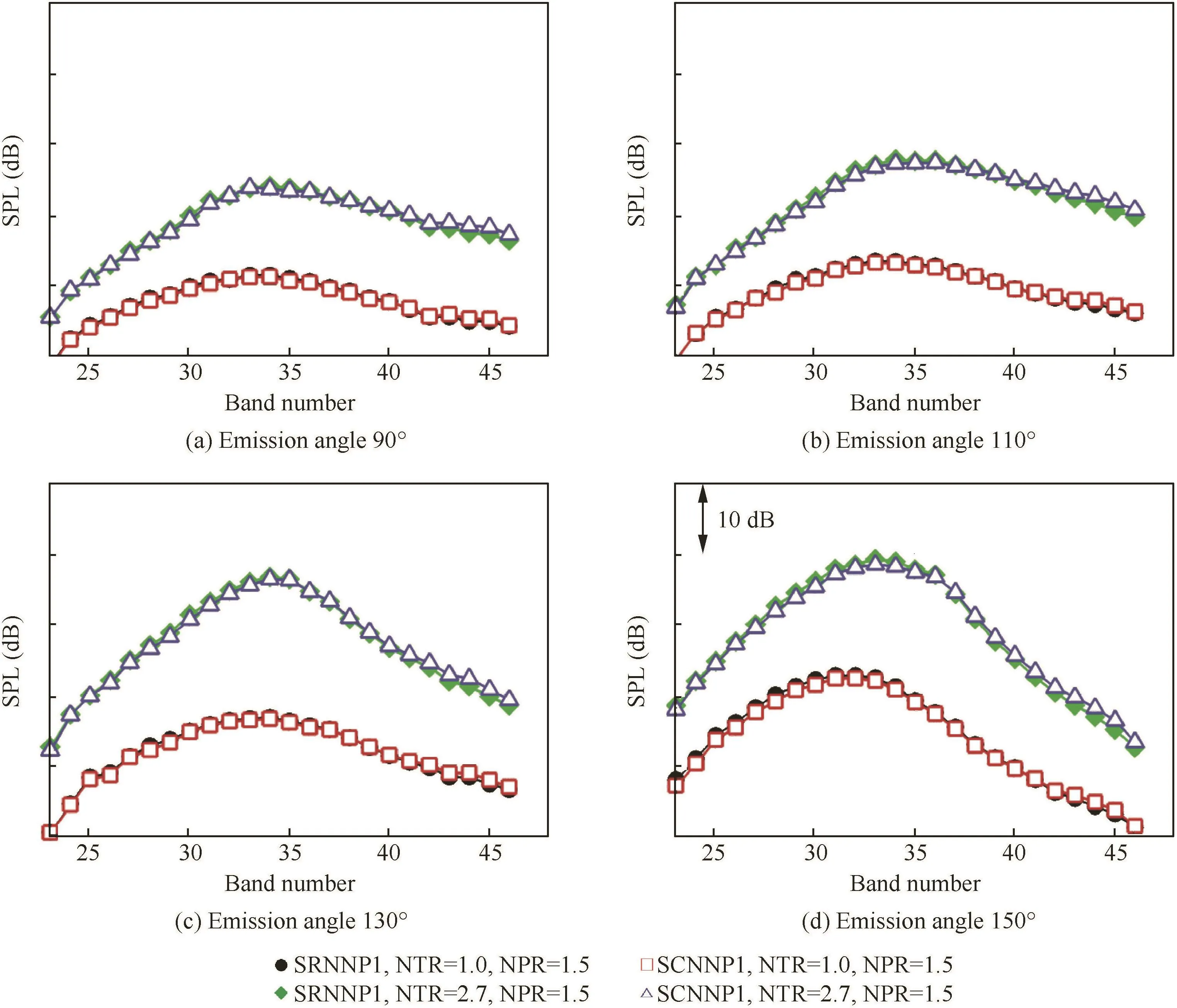
Fig.12Spectral comparison of nozzles without a plug for two gas conditions.

Fig.13Typical delta contour between conventional round nozzle and chevron nozzle:SCNWP1–SRNWP1(NTR=2.7,NPR=1.7).
Fig.14 shows the detailed spectral comparison of three nozzle configurations,SRNWP1,SCNWP1,and SCNWP2 at various nozzle operating conditions:Figs.14(a)to(c)for heated jet and Fig.14(d)for the unheated jet.From the first three figures,which show the spectral comparison for three different NPR values while NTR is fixed at 2.7,it is clearly observed that the reduction at peak band numbers increases as the angle increases and the lift at high band numbers is most pronounced at 130?and decreases after 130?.The reduction at peak band numbers and the lift at high band numbers could be interpreted that chevrons transfer energy from peak bands to high bands.In other words,chevrons induce the generation of small-scale fiow structures,so the strength of large-scaleflow structure is reduced relatively.
The reduction in peak band numbers becomes more evident as the NPR increases while the lift at high band numbers is almost consistent at a particular angle for various nozzle operating conditions.In Fig.14(c),it is shown that the maximum reduction in peak band numbers is around 10 dB at 150?and the maximum lift at high band numbers is around 10 dB at 130?.The reduction in the aft arc is significant however the lift is also significant and not negligible extraordinarily at mid angles.For example,at 110?,the highest spectral amplitude of the chevron nozzles is even higher than the peak amplitude of the round nozzle due to the significant lift at high band numbers.Therefore,considering the reduction and the lift together,the chevron nozzle designed and tested in the experiment is expected to have limited impact on noise.The calculation of OASPL(Overall Sound Pressure Level)indicates that the noise reduction achieved by adopting the chevron nozzle would be about 0.8 dB at the nozzle operating condition of NTR=2.7 and NPR=1.7,which is not very significant.
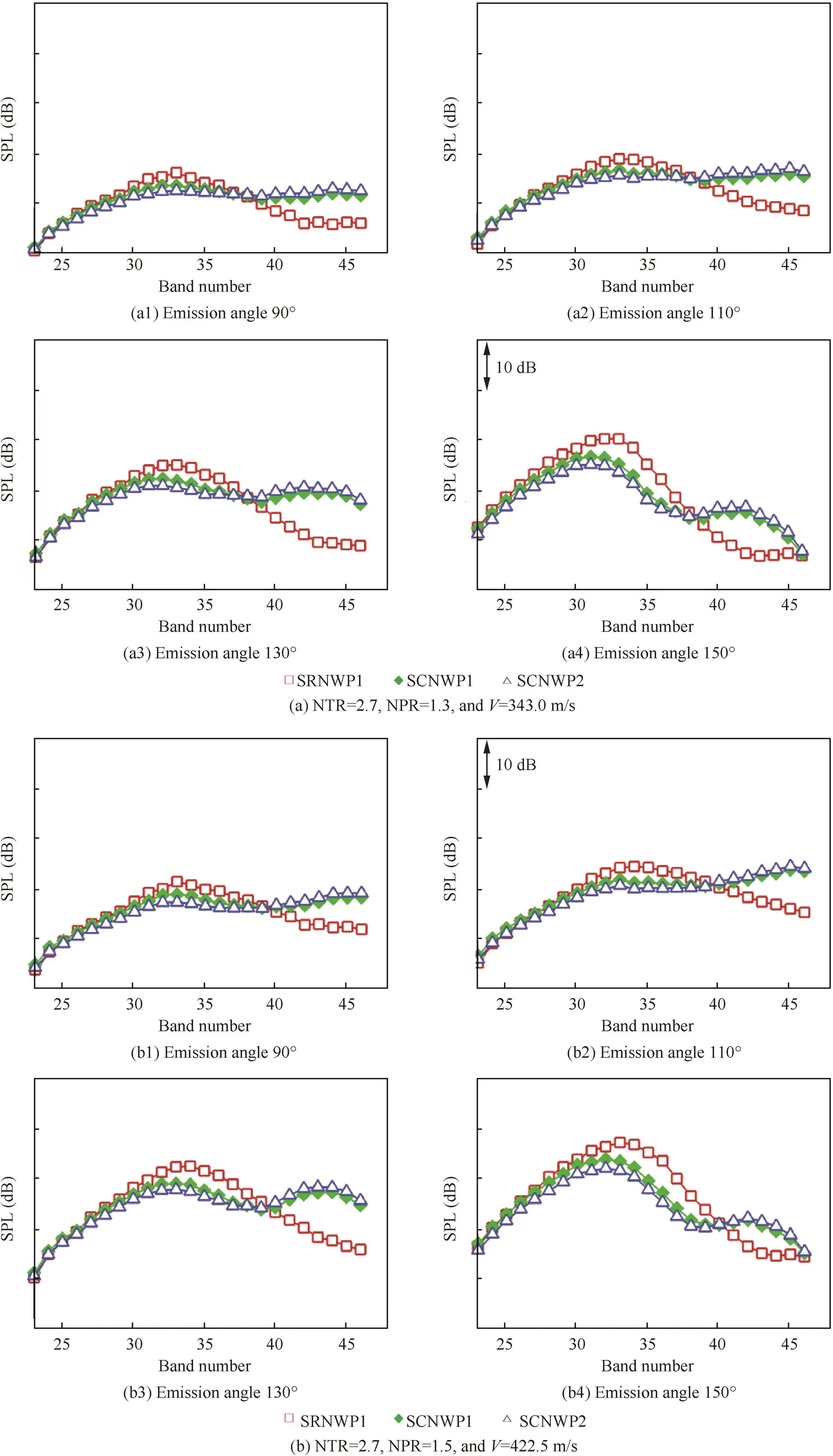
Fig.14Spectral comparison of three nozzle configurations with a plug.

Fig.14(continued)
Fig.14(d)shows the spectral comparison of SRNWP1,SCNWP1,and SCNWP2 for an unheated nozzle operating condition.By comparing Figs.14(c)and(d),which have the same NPR value of 1.7 but different NTR values,it turns out that the chevron nozzles become less attractive for unheated jets.At 150?in Fig.14(d4),the reduction in peak band numbers is about 6 dB,which is smaller than the reduction at 150?in Fig.14(c4),and there exists a definite lift at high band numbers,which is not observed in Fig.14(c4).At 130?,the reduction of the unheated jet is also smaller than that of the heated jet.Itcan be concluded thatthecurrent chevron design is more efficient at high NTR and high NPR conditions.
In addition,it could be concluded that SCNWP2 shows the slightly better benefit on noise reduction than SCNWP1 at peak band numbers however it shows more penalty at high band numbers.Though the difference between two chevrons is not significant in OASPL calculation,this conclusion would introduce additional topics for the optimization of the shape of chevrons.Because the basic shape of the two chevrons such as the height and the width of each tooth is almost identical and the only difference is the treatment at the tip and at the valley,one is sharp,and the other is smooth.Therefore,a parametric study on the shape of chevrons would give a chance to find an optimized shape for a specific nozzle operation condition.It would also be interesting how chevrons work if they are implemented in the configuration of dual nozzles.
4.Conclusions
A noise test was carried out in the anechoic chamber at Beihang University to investigate the detailed characteristics of jet noise from single-stream nozzle exhaust geometries.The spectral characteristics are investigated,and the effects of the following parametric variations are reported in this paper:impact of nozzle operating conditions on spectra;impact of the presence of a plug;and effectiveness of chevron configurations for noise mitigation.
The spectral change due to pressure is shown at all band numbers for unheated conditions,whereas it is more pronounced at high-frequency ranges for heated conditions.An impact of the presence of a plug is also clearly observed.The reduction of noise is moderate up to band number of 35,and becomes more significant at higher band numbers.It is recommended to develop a simple model for the impact of a plug,which consists of two parts:one part is the low-to-mid band numbers independent of NPR and the other part is the high band numbers dependent on NPR.Chevron nozzles,which reduces spectrum at peak frequencies and especially at aft angles and induces an increase of high-frequency components,are more efficient at high NTR and NPR conditions.And the blunt chevron shows slightly better performance than the sharp chevron.
It is expected that the observation and the analysis could be used for the development of the prediction of jet noise from the single jet,which will be the baseline for the development of the jet noise generated by turbofan engines of high BPRs.
Acknowledgements
The authors thank Mr.Zhi DENG of BASTRI of COMAC,and Prof.Xiaodong LI of Beihang University for supporting the test.The support of Mr.Zhiyuan XU for scheduling and conducting the test,and maintaining facility and measurement system is greatly appreciated as well.
杂志排行
CHINESE JOURNAL OF AERONAUTICS的其它文章
- Aeroservoelastic stability analysis for fiexible aircraft based on a nonlinear coupled dynamic model
- Experimental research on rotating detonation with liquid hypergolic propellants
- Investigation of straightforward impedance eduction method on single-degree-of-freedom acoustic liners
- Experimental characteristics of a two-electrode plasma synthetic jet actuator array in serial
- Aircraft robust multidisciplinary design optimization methodology based on fuzzy preference function
- Direction finding for two-dimensional incoherently distributed sources with Hadamard shift invariance in non-uniform orthogonal arrays
